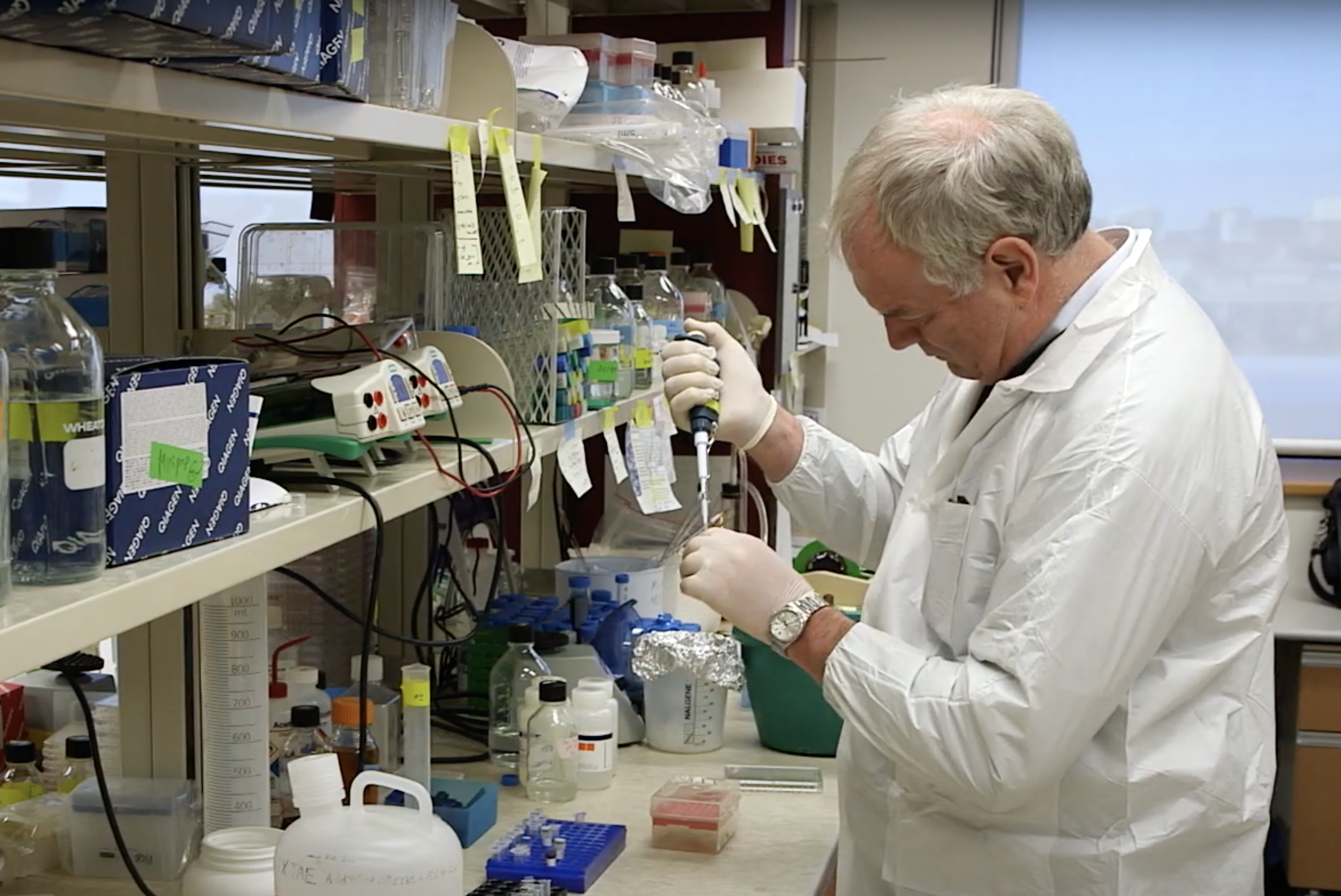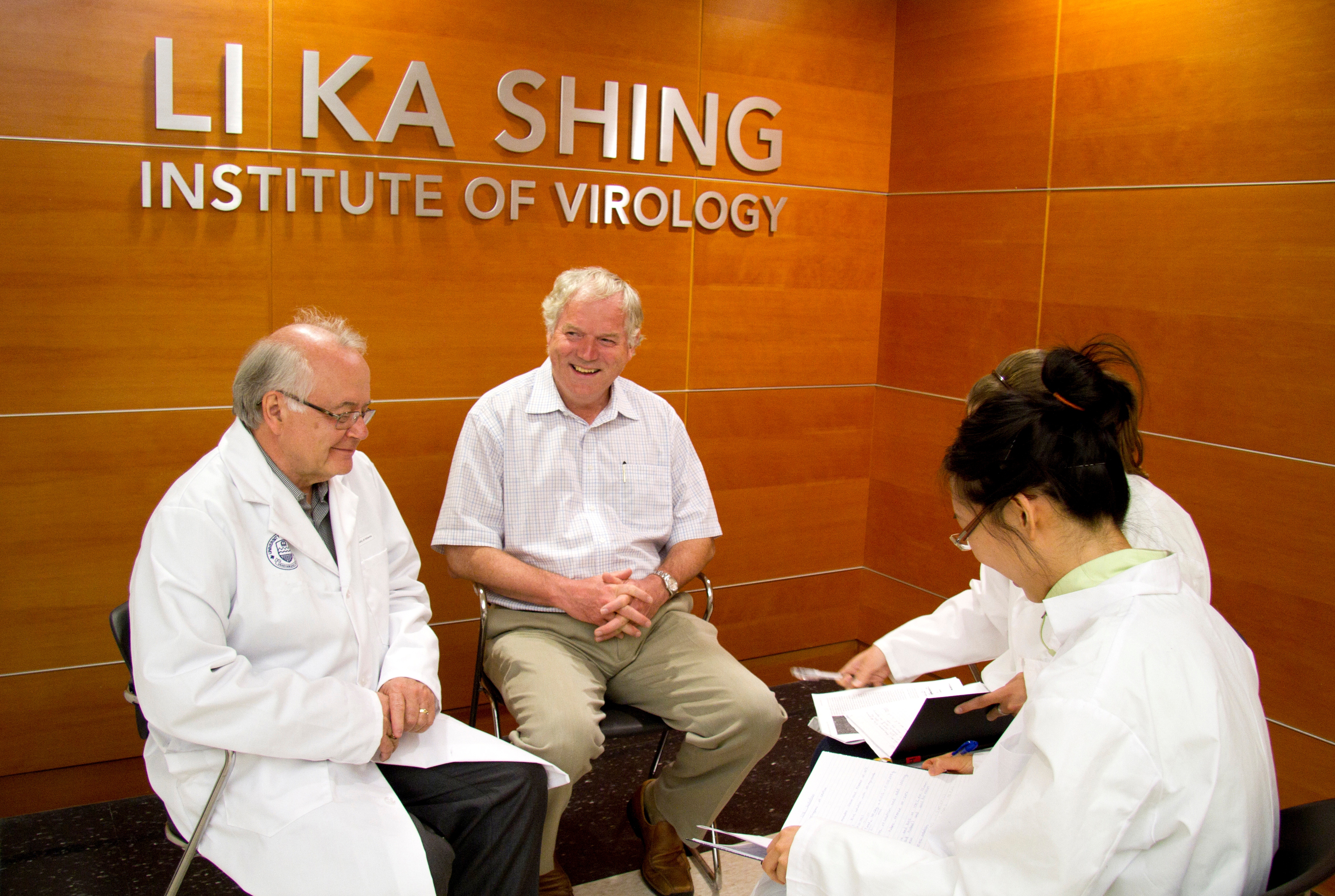University of Alberta staff and students are celebrating Nobel prize-winning medical researcher Michael Houghton and the contributions he has made—to human health, to his colleagues and students, and to the U of A community as a whole.

Houghton was awarded the 2020 Nobel Prize in Physiology or Medicine along with Americans Harvey J. Alter and Charles M. Rice for their collective work on hepatitis C, which allowed researchers to identify, understand and ultimately treat the deadly disease.
Houghton was a young researcher at Chiron Corporation, an American pharmaceutical company, when he began searching for the hepatitis C virus (HCV) in 1982, back when it was only known that it was not hepatitis A and not hepatitis B, and it was making people very sick.
The hunt took seven years, and Houghton shared credit with co-discoverers Qui-Lim Choo and George Kuo when they finally unlocked the genetic code of the virus in 1989.
Millions of lives were saved when the risk of contracting the blood-borne illness from tainted transfusions was eliminated thanks to widespread testing that could only have been developed after the mystery of hepatitis C was revealed.
Houghton has spent the 30 years since that discovery looking for ways to battle hepatitis C, ten of them working on a vaccine at the U of A’s Li Ka Shing Institute of Virology.
Having turned down a prestigious scientific prize from the Canada Gairdner Foundation in 2013 because his co-discoverers were not included, Houghton told a news conference he was delighted to be recognized by the Nobel committee.
“What counts for me even more is that we've been able to prevent millions of infections that otherwise would have occurred around the world through the blood supply when people got transfused and had blood products.”
Effective antiviral drugs have since been developed to treat the estimated 71 million people worldwide who are infected with hepatitis C, but Houghton said the drugs are expensive and not available everywhere. HCV can go undetected for many years without patients knowing they are infectious. It can eventually lead to severe liver disease and kills 400,000 each year globally.
“As with any epidemic, to actually really stop transmission you need a vaccine, and I am very optimistic that we have an improved vaccine to use against hep C,” Houghton said. “We are manufacturing it now here at the U of A and are hoping to begin clinical trials next year.”
According to colleagues and students, Houghton has always kept his focus on patients, even when he was carrying out the basic science on the viral genome.

Impact on patients: Hep C doctor Stephen Shafran
While Houghton was tackling hepatitis C in the lab, Stephen Shafran has spent his career seeing patients from all over northern Alberta who benefit from the discoveries Houghton and his colleagues made. Shafran is medical lead for the Hepatitis Support Program at the University of Alberta Hospital and infectious disease professor in the Faculty of Medicine & Dentistry.
“In high-income countries like ours, regrettably the most common way to get a hep C infection is through illicit injection drug use,” Shafran said. “In low-income countries it’s probably mainly through health care, where staff must sterilize and reuse needles for medical and dental procedures.”
Shafran said the disease can be silent for decades, so boomers who stopped taking drugs years ago may have it and unknowingly pass it on to others, while young people who are trying drugs for the first time are also vulnerable. The current opioid crisis has made the risk even higher, Shafran said. HCV can also be contracted by health-care workers from accidental needle pokes, and the risk of transmission is elevated for people who have HIV.
“It will cause liver scarring, then some people will develop cirrhosis and some will develop liver failure or liver cancer,” Shafran said. “Some will even need a liver transplant.”
When Shafran first began treating HCV patients they had only poorly effective interferon-based drugs that had to be injected and caused many negative side-effects. Since then, researchers have been able to isolate key viral proteins and develop drugs to inhibit them. Now patients can take a pill once a day for two or three months and rid themselves of the disease.
“These treatments are spectacular, with almost no side-effects,” said Shafran. “The ability to cure people is phenomenal.”
“There’s no way these drugs could have been developed without understanding the whole viral genome and what the targets are, and that’s all based on Michael’s work,” he said.
Shafran said while some in the field believe the drugs are so effective there is no need for a vaccine, he pointed out that sexually transmitted infections such as syphilis, gonorrhea and chlamydia have not been eradicated and they can be cured with a single dose of a relatively inexpensive drug.
“We still need a preventative vaccine because people continue to engage in high-risk activity,” he said. “I'm hoping Michael Houghton and his vaccine team will be successful.”
Impact on trainees: Post-doctoral fellow, research scientist Deanna Santer
Deanna Santer had done her undergrad at the U of A but headed to the University of Washington for her PhD. When she was looking around for a post-doctoral placement and heard that Michael Houghton had just been recruited to U of A as a Canada Excellence Research Chair, she knew she wanted to come back. She was one of four young scientists hired in the first months the lab was open, and was promoted to research scientist in 2017.
“I was there from the beginning, back when we had to completely set up the lab, and we built it from the ground up with a great team including Darren Hockman, Michael Logan and Amir Landi,” she said. “I knew of Michael’s amazing work thus far in virology, and he’s why I decided to come to the U of A.”
Santer worked with Houghton on the hepatitis C virus and then branched off into interferon biology. She had to join the lab’s Nobel celebration party this week by video conference because she is in the middle of moving to Winnipeg to take up a position as assistant professor and GSK Research Chair of Immunology of Infectious Disease at the University of Manitoba.
“Michael always supported me to build my own independent research career bridging immunology and virology and how they interact with each other,” Santer said. “He’s just one of those people who wants all his trainees to succeed and reach their goals.”
From Houghton, Santer said she learned that science is a team sport and it’s best to play the long game.
“A quality that really stands out to myself and others in the lab regarding Mike is his persistence and determination when he tells his story of how long it took to discover the virus,” she said. “And during his time at the U of A, for the dedication needed to develop and manufacture a clinical trial-grade HCV vaccine, overcoming obstacles that have come up along the way.”
Santer said she shares Houghton’s interest in doing research that will benefit people, no matter how long it takes.
“Michael always said we need funding for basic science—even if your project seems small at the time, that those initial building blocks are needed to develop future drugs, therapies and vaccines,” Santer said.
“He knew the end goal in all our projects was how this can help a person—it’s not just thinking about cells in a dish.”
Houghton’s prize is the first Medicine Nobel awarded to a scientist based at a Canadian university (Houghton is an American and British citizen) since 1923 when the University of Toronto’s Frederick Banting and John Macleod won for the discovery of insulin.
Santer hopes it will put Canada, the University of Alberta and virology on the map, helping to recruit top students, researchers and funding.
“It would be great to build on what we’ve already developed here, especially during COVID-19, which has raised awareness for the development of new antiviral drugs and vaccines in general,” she said.

Impact on the university: Virologist Lorne Tyrrell
“Michael’s work has affected millions of people and it is such a just reward,” said Lorne Tyrrell, founding director of the Li Ka Shing Institute of Virology.
Tyrrell chuckles when he recounts how the Nobel committee did not have Houghton’s phone number, so he was the one who broke the good news.
Tyrrell recruited Houghton to the University of Alberta in 2010 and asked him to take the lead on the Applied Virology Institute when it was set up in 2013, tasked with taking scientific discoveries to market.
“When we set up the institute, Mr. Li felt it was very important not only to make discoveries, but to bring them to patients,” Tyrrell said. “Michael had a lot of experience in industry and he had made a discovery that had a huge benefit to patients.
“Michael continues to focus on that—how can we work together to improve the lives of patients?”
Tyrrell is hopeful that Houghton’s hep C vaccine project, on which he is co-principal investigator, will be successful.
“Other than clean water, the thing that’s had the biggest effect on human health in the world is vaccines,” said Tyrrell. “We’ve seen it with polio, measles, mumps—how great vaccines have benefited mankind.”

Impact on the future of hepatitis C
For his part, Houghton plans to get back to work immediately following the excitement of the Nobel announcement.
He unfailingly gives credit to faculty colleagues and the team of young researchers he works with in his lab, which he manages remotely at the moment from his home in California due to COVID-19 restrictions. The team is scaling up production of the most promising hepatitis vaccine candidate in the world, since the recent failure of an American candidate in phase 1 trials.
“Our progress is due in large part to our team of highly skilled virologists, immunologists, biochemists, cell biologists and QA/QC staff within the Li Ka Shing Applied Virology Institute,” Houghton said.
“We have a great team of about 20 young people, most trained in Canada, who are manufacturing and purifying the vaccine,” he said. “We are up to our necks in that right now—we have a lot of work to do every day. “
They hope to begin phase 1 human trials by the end of next year in the U.S., Germany, Italy and Australia, but Houghton said even if the vaccine proves effective in humans, it could still take six or seven years to get it ready for widespread inoculation of high-risk groups.
He said COVID-19 has moved the bar on the speed of research and understanding of what it takes to tackle viral illness.
“COVID, as terrible and as tragic as it is, has created a new paradigm for developing vaccines,” he said. “We see now how fast we can develop them when the will is there.”
“We believe that a hepatitis C vaccine is possible and that we have a real chance of eradicating this infection from the planet over the next 20 or 30 years,” he said. “The quicker we do it the better, because it's a very nasty disease.”